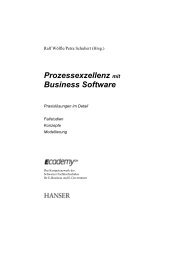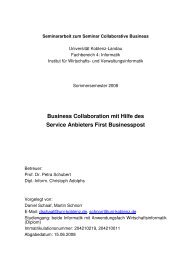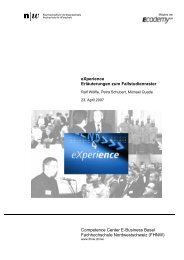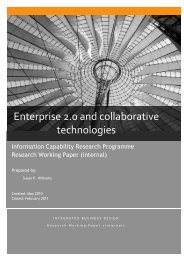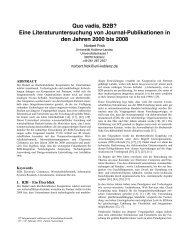HOW THE ORGANIZATIONS CHANGE IN ERP IMPLEMENTATION
HOW THE ORGANIZATIONS CHANGE IN ERP IMPLEMENTATION
HOW THE ORGANIZATIONS CHANGE IN ERP IMPLEMENTATION
You also want an ePaper? Increase the reach of your titles
YUMPU automatically turns print PDFs into web optimized ePapers that Google loves.
YehHow the organizations change in <strong>ERP</strong> Implementationconcerns (legacy system integration), business concerns (the busy season), training concerns (head count of end users wasover 300) and other requirements, the “go- live” date was delayed to January 2004.Content – First PeriodThough the project started in 2000, during 2000-2002, the project team struggled in terms of achieving a competitiveadvantage and the development of a good business model. Dr. Fen’s information system strategies were globalization andcentralization. He developed a five year plan for Shine’s group information system. He attempted to establish a core andcorporate business process. Lacking solid organizational support, Fen was forced to compromise the ideal and rather thanreengineer and completely redesign the process, he opted for a more gradual improvement approach.However, the vision or the ‘to-be’ component of the approach was always problematic for Fen to deal with. Basically the‘to–be’ position was dependent on the top management’s vision. Unfortunately their vision was different to that held by Fen.Importantly, top management was responding to a general trend in the semiconductor industry towards declining prices forproducts and services of a given technology over time So, due to the characteristics short cycle time in the industry, topmanagers were understandably eager for short term profits.Social Process under Dr. FenThis section analysis involves cultural and political perspectives on the process of organizational change associated with theimplementation of the <strong>ERP</strong> system.Cultural PerspectiveTo enable its turnkey strategy, which consisted of the integrated packaging, testing, and shipment of semiconductors toend-users designated by the customers, Shine started to centralize its administration departments and information systems in1999. Shine defined the <strong>ERP</strong> project as “GRP” for “Group Resources Planning”. Then, the implementation of the <strong>ERP</strong>system demanded new methods of designing tasks, jobs and work modules and led to new work structures and procedures.Both sites provided their requirements in business process design, but the requirements were often perceived to be in conflict.As well as inter-site conflict, there was interdepartmental functional conflict in regard to the necessary requirements. Due to alack of business transaction and system understanding, there were ongoing difficulties in cross-departmental communication.Further, the various functional managers retained an ignorance of the impact of the project. In fact, they preferred to remainlargely ignorant of the project altogether and to focus on short term accountability goals. Accordingly, they rejected the6



